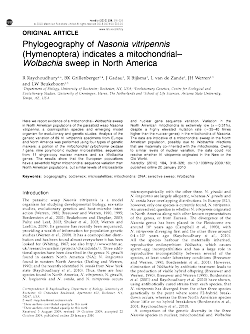Graduate Research
Opportunities for graduate research are available in the Werren Lab to study evolutionary genetics and genomics of insects and their microorganisms. Our broad goals are to understand (a) how complex traits (e.g. behavior, development, gene regulation) evolve at the genetic level, and (b) the role of bacterial symbioses in shaping evolution of eukaryotes. Our primary study organisms are the emerging genetic model system Nasonia (a small and laboratory tractable parasitoid insect) and bacterial associates of insects (e.g Wolbachia and Arsenophonus).
This is a particularly exciting time in my laboratory as both Nasonia and symbiosis are rapidly growing as research areas, and this presents special opportunities for motivated individuals to contribute to an emerging field. Nasonia is complex of closely related species that is an excellent genetic model for studies of complex traits and evolutionary genetics of speciation. Active current projects include identification and cloning of quantitative trait loci (QTL) involved in behavioral and developmental differences between species, studies of epigenetic inheritance (DNA methylation and genome imprinting), and investigations of the role of nuclear-mitochondrial interactions in hybrid incompatibility. Our research on microbial symbioses focuses on two basic questions. First, we wish to determine to what extent lateral gene transfers from bacteria to eukaryotes results in acquisition of novel gene functions. Second, we are investigating how bacteria-host interactions co-evolve, and whether these interactions promote genetic divergence and speciation of hosts.
Interested students should contact Dr. John (Jack) Werren. The University of Rochester has a strong PhD program, particularly in the fields of evolutionary and ecological genetics, providing an excellent intellectual and training environment. See the the Ecology and Evolutionary Biology blog for more information.
Suggested Reading
Werren, J.H., S. Richards, C.A. Desjardins, O. Niehuis, J. Gadau, J.K. Colbourne, et al. 2010. Functional and evolutionary insights from the genomes of three parasitoid Nasonia species. Science: 327(5963)343 - 348.
Pultz, MA and DS Leaf (2003). The jewel wasp Nasonia: querying the genome with haplo-diploid genetics. Genesis. 2003 Mar;35(3):185-91.
Werren JH, L. Baldo L, ME Clark (2008). Wolbachia: master manipulators of invertebrate biology. Nature Reviews Microbiology. 2008 Oct;6(10):741-51.







